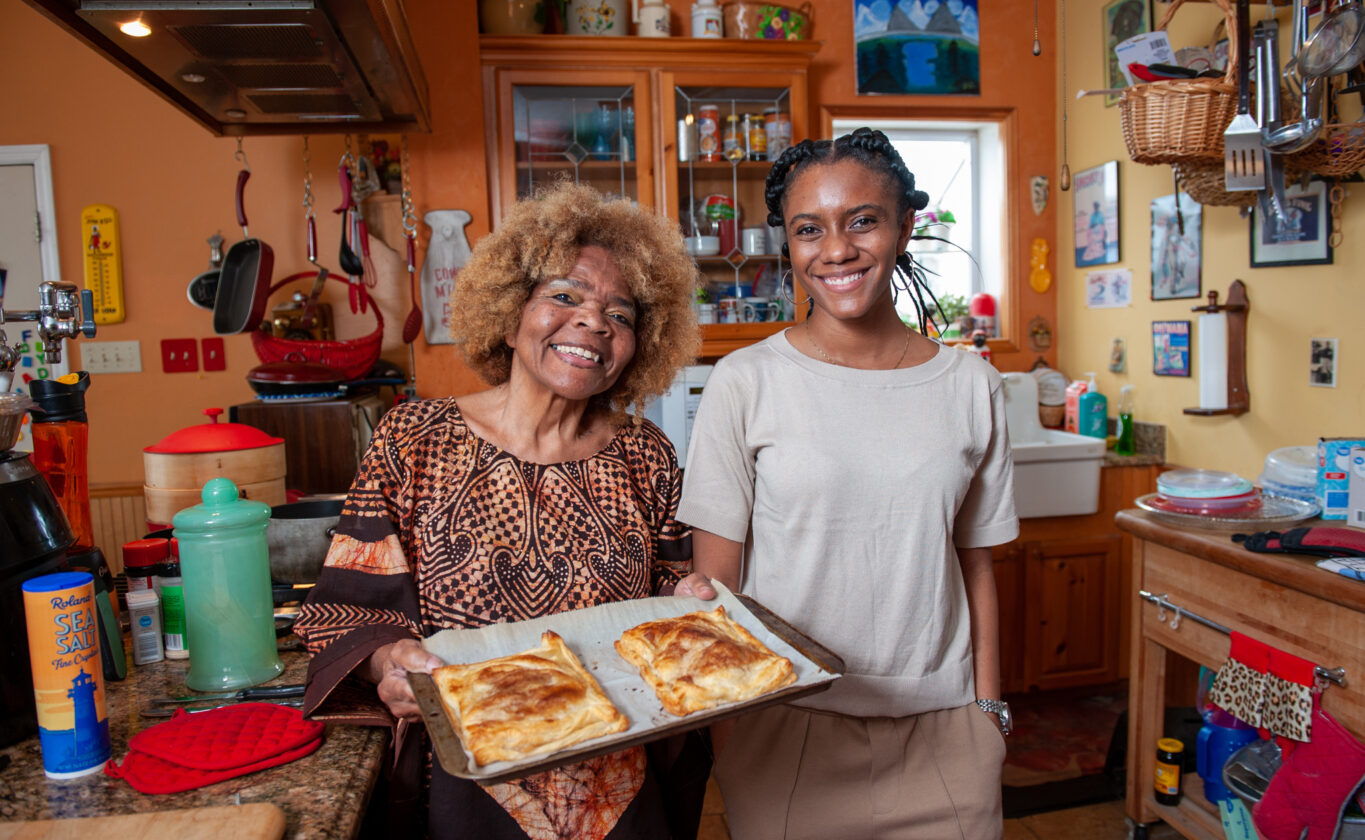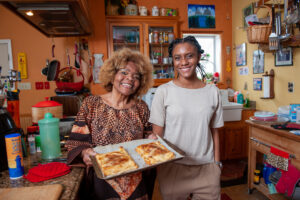
Photo credit: Lindy Drew / Humans of St. Louis
Janice: My mom and dad were born and raised in St. Louis City and so was I. I went to Catholic school and became a public school teacher. My husband’s a public school teacher. And we decided to move to the City and make it a better place. We’re in Hyde Park and moved here about 38 years ago from living in North County. This is my first grandbaby.
Cami: I was born and raised in St. Louis. As early as I remember, I’ve been coming here. This is where I spend a ton of my time and feel like I was raised. This is my mom’s mom. Having grown up in North County, I had my friends there, but coming here definitely influenced how I look at and feel about the City.
Things aren’t always easy on the Northside of St. Louis City. There are definitely aspects of the community and neighborhood that needed work and addressing. But something my grandparents taught me that I still carry is what it means to love a place and stay in a place. It’s easy to point out the things you don’t like about a neighborhood or make comments about what needs to change. It’s another thing to dedicate yourself to staying in a place and work towards building it better and safer and envisioning it to where you want it. I admire that my grandparents did that. This is a beautiful house in a beautiful neighborhood and they didn’t give up and abandon it.
Janice: Well, it didn’t start off that way. When we first moved here, it was horrible. People who didn’t care about anything were living next door and we had break-ins on both sides of us. We’d call the police. And it was like, ‘We can’t stay here. We gotta move.’ But I was determined. Nobody was gonna run me out. I was gonna stay, tackle it, and see how I could make it better. Any material things they took, I could always replace them and get more. You can’t solve all the problems, but if you can be a good example to your kids and your grandkids, and to the neighborhood, that’s the biggest lesson of all.
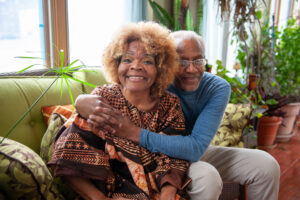
Janice: Our house was in an abandoned neighborhood with a lot of drug dealing and crime. Buildings were being torn down and there was a lot of decay. I grew up in the City on Cass Avenue. My grandpa lived right across the street and it was a joy to have lots of family live around you, surrounding you and loving you. We always had cousins and uncles right there. That was a safe feeling. The building we lived in isn’t there anymore, but I always drive down Cass, look over, and say, ‘Hey, Grandpa.’
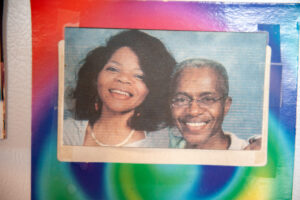
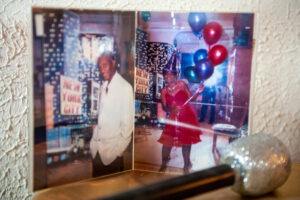
Janice: I went on with my education to Fontbonne and then Harris-Stowe. Then I decided with my third husband, Jerry, that we’d move to the City, love the City to make things better, and be an example of giving back to keep the neighborhood together. We’ve added so much to this house that now it’s my mansion. We couldn’t have this if I was in Clayton or any expensive neighborhood with so many restrictions. I know there’s crime all around us, but you can’t keep running from it. So I came and became part of the solution.
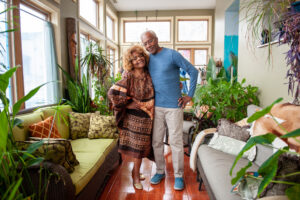
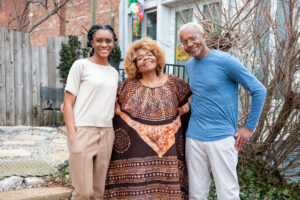
Cami: Having my grandparents from the City, I see it the same way as my grandma says — where to love something is to invest in it. Love isn’t just a word, it’s an action. So if you love a place, city, or community, but there are no actions to show it, then how real is that love? One way is moving somewhere, staying, building, starting a business and hiring people — whatever it is for you to see things change and not just accept things the way they are. It’s easy to say an area’s dangerous or to accept a system as ‘it is what it is.’ But if you want to see things be different, safer, and better, invest to be able to make it work.
My family is incredibly tight-knit. We have a lot of cousins, uncles, and aunts scattered all around. I remember before you could go on the DNA websites to see where you were from, my grandma sent me to the library downtown to do research on our family. I was like, ‘I don’t know how to do that!’ But, I went and searched. And as far back as I could go was still in St. Louis.
For me, and especially for Black Americans of the West African slave trade, sometimes we walk around with an attitude like we don’t have any roots or we’re so disconnected from a place. But when I started to do my research, I realized I am so deeply rooted to this city and this community is why I’m here. It’s why I exist. It birthed me and the people before me. I was born in a St. Louis hospital and I came from St. Louis parents who came from St. Louis parents. That alone makes me feel like I owe it to my city and to myself to stay here, build here, and create here. There’s no other place I’d rather do those things than in this city with my family and continue that St. Louis legacy.
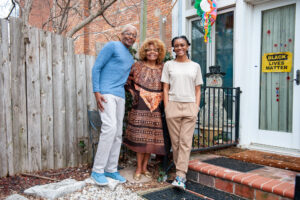
Janice: There weren’t any of the buildings in our neighborhood when we moved here. Some were falling down and in decay. The first thing we did was join the neighborhood association and work with the alderman. We were part of the crime watch and trying to help build up our area in Hyde Park. Then people started building up around us. It was like, from murky waters rises the lotus. And this is my Buddha land, it’s my happy land. We’re not rich, but we’re rich in love and heart.
Growing up, it can be scary being a kid because you’re warned about, ‘Don’t do this, don’t do that. Look out for Mr. So-and-So. You’ll get kidnapped,’ or whatever. Going to bed, you’d think something was under your bed or in the closet. You always have a little fear somewhere, but that’s being human to be aware of your surroundings because some negative things can happen to you. Then again, the more beauty you make around, the more evil that will stay away. So I joined with like-minded people to see how we could work together to find camaraderie to make things better.
The fear comes from TV and reading the news and hearing this is a high-crime area. We have seen deals with cars stopping and all that, but it’s not just here. It seems to be everywhere. We’re not foolish about it. We definitely get alarm systems. Like, when something happened to my granddaughter, I wrote it up and warned the neighbors by walking door to door to make them aware things have happened on our block. We do alert the alderman to call the police, because, yes, a lot of people are scared to report on who’s doing what in fear of retaliation from the criminals. But you gotta be brave and strong, too, like the women in my family who are brave and fearless. Wakanda forever!

Cami: Why here and why stay here? I have traveled and lived in other places. A lot of my family are educators, and I’ve learned if you’re going to teach something, you have to really really know it. So from a creative standpoint, for me to create well or feel like I’m putting my heart and soul into the work, I want to be creating from a place that I know. And I don’t know anything better than where I’m from. It’s who I am. I’m still getting to know myself, but the more I do, I realize how much it’s informed by this city.
So I stay here because, when I’m gone from here, I feel like I’m always trying to reach into my core, into my soul. Then when I’m back here, I realize, I’m back and I’m plugged in. It feels like a charging port to me. Everything that’s me is here in this land. Sometimes I look at my arms and my skin in the sun and the way it turns a dark brownish-red reminds me of the bricks on the North side. I feel like I literally am from the dirt of this place. It’s that deep for me. It’s like a magnet for me. That’s why I always wind up coming back.
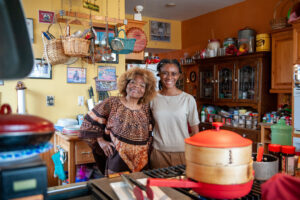
Janice: It’s probably your ancestors calling you back. They want you to finish what we started, like, ‘Keep going. We’re looking down on you. We’re seeing you. You’re making us feel strong. Our struggle wasn’t for nothin’.’

Cami: Before I moved to Chicago, I was living here, and I’ve come back to this house at night at various times of the day. And there was a situation on February 27th of 2018 where I came back from hanging out with my friends at Mission Taco in the Central West End. It wasn’t that late, but it was after 1 a.m. in the morning, I parked, and I noticed there were people parked across the street, but I didn’t pay much attention. I was also doing this thing in my head like, ‘They’re coming home, I’m coming home.’ So I got out of the car and, before I knew it, this kid who looked 17 already had a gun drawn. It wasn’t against my head, but it was against my head in the sense that this kid had a gun. And he had plenty of time to shoot if that’s what he wanted to do.
I don’t know what happened or what took over, but reflex-wise, I went back in the car, turned the key, and ducked down as I drove away. He shot towards something and I just drove and drove and drove not even looking. I’m happy I didn’t hit anything, but I was like, ‘Where do I go?’ And that was the one time in my life I had ever driven to a police station. I wasn’t even driving there. I was just driving and I saw it. So I stopped by to tell them what happened. And at the end of the day, there was nothing that could be done. Because in that situation, like many, the police don’t stop crime from happening. Maybe there was someone they could have sent over, but in my head, that kid was gone. He wasn’t staying there waiting to get arrested. And if they see someone who fits that description, chances are that’s not even the person. So I was thinking, ‘Now I could bring harm to that person if I gave a description,’ and I ended up just not.
The police kind of did the whole, ‘Well, that’s how it is. That’s the neighborhood. Have you considered moving?’ Is that really the solution — to move? I left and told my parents and my grandparents. My grandma told the neighborhood to be on the lookout. As far as safety is concerned, the safety I leaned into was my family. The actual thing that happened afterward was the community reaction and my family’s reaction towards me.
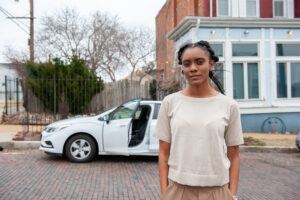
Cami: I’m okay; I’m fine. Not saying I didn’t have some PTSD. Like, I don’t like when people walk up to me while I’m in my car. But I remember how young that young man looked and I wanted to shake him by the shoulders, like, ‘What are you doing? Where should you be right now? Are you doing this for money or to be accepted?’ For our worlds to have converged in that way means so many people missed the opportunity to guide him back to whatever path. It should be the family, it should be the teachers — all of these checkpoints of a community that clearly failed him because he wasn’t intercepted. So I’m more interested in, what are the programs that make sure he isn’t in survival mode, or whatever his reasons were? I walked away just fine, but this kid — I don’t know if he made that decision with the wrong person the next day and got killed himself.
—
Janice and Jerome Jernigans are Hyde Park residents and Cami Thomas is a North St. Louis County resident.
Jia Lian Yang / Forward Through Ferguson and Lindy Drew / Humans of St. Louis contributed to this photo story.
This story is a collaboration between Humans of St. Louis and Forward Through Ferguson for #Transforming911, an accountability and advocacy tool that examines St. Louis’ 911 system and serves as a call to reimagine public safety.
Learn more and get involved at transforming911.org.

